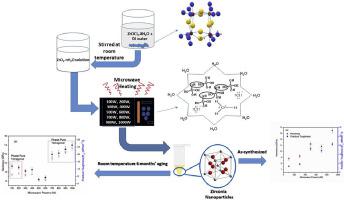Journal of the Mechanical Behavior of Biomedical Materials ( IF 3.3 ) Pub Date : 2020-08-21 , DOI: 10.1016/j.jmbbm.2020.104012 Tanzeela Batool 1 , Bushra S Bukhari 1 , Saira Riaz 1 , Khalid M Batoo 2 , Emad H Raslan 3 , Mohammad Hadi 3 , Shahzad Naseem 1

|
It is well known that long term stability in zirconia has been a problem because of the structural alteration from stabilized tetragonal zirconia to monoclinic that leads to fracture in implants. Microwave (MW) assisted sol-gel synthesis is employed in the present work to prepare stabilize zirconia nanoparticles. ZrOCl2.8H2O is used as a precursor whereas de-ionized water is used as a solvent. Power of microwave radiations is varied in the range of 100–1000W. Zirconia nanoparticles have been characterized under as-synthesized, 6- and 12-months’ room temperature (RT) aged conditions. Metastable phase (MP) of zirconia, appearing under as-synthesized conditions, transforms to phase pure tetragonal zirconia (t-ZrO2) after RT aging that was prepared with MW powers of 100, 200 and 700–1000W. Whereas, MP transforms to mixed tetragonal-monoclinic phases at microwave powers of 300–600W after RT aging. XPS results show presence of oxygen-deficient state of ZrO2 lattice along with surface defects contributing towards the tetragonal zirconia phase under all conditions. Value of dielectric constant (i.e. ~11–12 at log f = 4.0), hardness (~13 GPa) and fracture toughness observed under all conditions are well in agreement to be used for biological implants. Disks of aged t-ZrO2 nanoparticles are checked for their biodegradation test by dipping in simulated body fluid for several weeks. ZrO2, with 26 weeks of immersion, shows small loss in hardness and weight. Stabilized tetragonal zirconia shows strong anti-oxidant activity. Stabilized ZrO2 nanoparticles presented strong antibacterial activity against both gram positive (S. aureus, Bacillus) and gram negative (E. coli) bacteria. Thus, structural and mechanical stability of zirconia (checked after 6 and 12 months) make this material highly beneficial for long term use in biomedical applications.
中文翻译:

微波辅助溶胶-凝胶法合成生物活性氧化锆纳米粒子-强度和结构的相关性。
众所周知,由于从稳定的四方氧化锆到单斜晶的结构变化导致植入物的断裂,因此氧化锆的长期稳定性一直是一个问题。在本工作中采用微波(MW)辅助的溶胶-凝胶合成来制备稳定的氧化锆纳米粒子。ZrOCl 2 .8H 2 O被用作前体,而去离子水被用作溶剂。微波辐射的功率在100–1000W的范围内变化。氧化锆纳米粒子已经在合成的6个月和12个月的室温(RT)老化条件下进行了表征。在合成条件下出现的氧化锆亚稳相(MP)转变为纯四方相氧化锆(t-ZrO 2)在RT老化之后,准备了100、200和700–1000W的MW功率。RT老化后,MP在300–600W的微波功率下转变为混合的四方单斜相。XPS结果表明,在所有条件下,ZrO 2晶格都存在缺氧状态,并且表面缺陷有助于四方氧化锆相。 在所有条件下观察到的介电常数(即,log f = 4.0时为〜11–12),硬度(〜13 GPa)和断裂韧性的值完全一致,可用于生物植入物。通过浸入模拟体液中数周来检查老化的t-ZrO 2纳米颗粒盘的生物降解测试。氧化锆2浸泡26周后,硬度和重量的损失很小。稳定的四方氧化锆具有很强的抗氧化活性。稳定的ZrO 2纳米颗粒对革兰氏阳性菌(金黄色葡萄球菌,芽孢杆菌)和革兰氏阴性菌(大肠杆菌)均具有很强的抗菌活性。因此,氧化锆的结构和机械稳定性(在6个月和12个月后检查)使该材料非常适合长期用于生物医学应用。











































 京公网安备 11010802027423号
京公网安备 11010802027423号